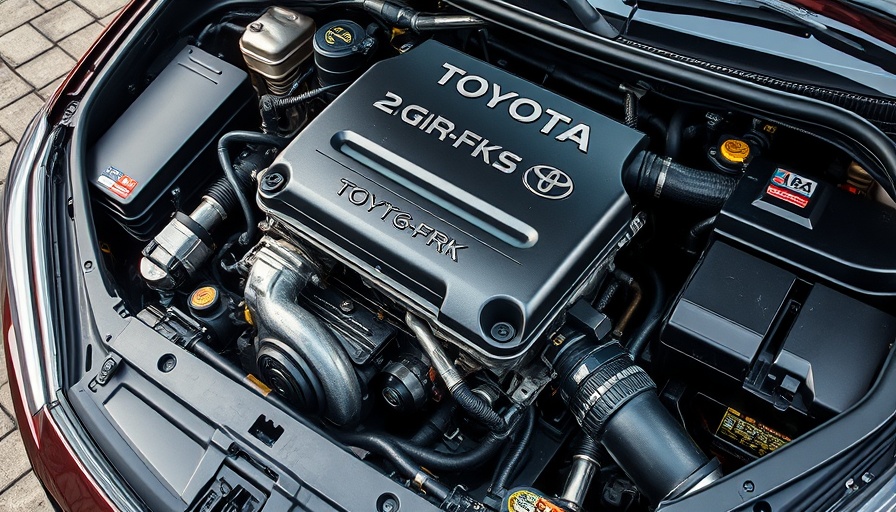
Why Toyota's 2GR-FKS V6 Remains a Beloved Choice Among Drivers
Amid the tide of turbocharged engines and hybrid marvels, few powertrains have stirred the passion of automotive enthusiasts like Toyota’s 2GR-FKS V6. Launched in 2015, this naturally aspirated 3.5-liter V6 engine has become a symbol of what a true driver-centric engine can be. In a world where manufacturers are increasingly pushing towards fuel-efficient options, the 2GR-FKS redefined the essence of V6 performance, combining reliability, power, and that nostalgic feel of responsiveness on the pedal.
A Durability Tested Over Time
What sets the 2GR-FKS apart? Its engineering draws from decades of Toyota's tradition of reliability. With a solid 295 to 301 horsepower range, depending on the model, this engine ensures smooth power delivery and a high-revving nature unlike any turbocharged alternative. A clear highlight of the 2GR-FKS is dual injection technology—both port and direct—that enhances fuel efficiency while retaining that beloved natural throttle response. Owners of cars equipped with this engine often cite the exhilarating feeling of acceleration and driving comfort, reinforcing Toyota’s long-standing reputation as one of the most reliable car brands.
Countering the Turbo Trend
As the automotive industry shifted its focus to turbocharged engines, the 2GR-FKS remained a powerful statement against this trend. Turbo engines, while efficient, often suffer from lag and a disconnected feel due to their inherent design characteristics. This is contrasted by the direct response of the naturally aspirated 2GR-FKS. Many drivers express a yearning for this engagement that brings them closer to the road—a driving experience that feels lost in today’s more electronically-assisted vehicles.
The Versatility of the 2GR-FKS
The versatility of the 2GR-FKS has allowed it to thrive in various Toyota and Lexus models, from family-oriented SUVs like the Highlander to luxury sedans like the Lexus GS. Each application showcases the same core strengths: linear power delivery, refined acceleration, and an emotional connection to driving that remains untainted by turbo lag. Particularly for drivers looking for vehicles that allow for spirited driving, the powertrain's adaptability makes it a must-have choice, ensuring Toyota’s lineup remains appealing in 2024 and beyond.
Fuel Efficiency: A Balanced Approach
Despite its raw power, the 2GR-FKS does not compromise on fuel efficiency. Sporting a respectable MPG rating compared to many modern engines, it strikes a balance that today’s drivers desire. As hybrid technology continues to gain traction among consumers seeking eco-friendly options, the naturally aspirated engine proves that high performance and efficiency can coexist harmoniously. The results in consumer satisfaction are tangible: real-world fuel economy ratings demonstrate that many drivers are still intrigued by how seamlessly Toyota manages to deliver on both metrics.
Looking Ahead: Future Insights for Toyota Owners
As we move further into the age of electrification and stringent emissions regulations, one might wonder about the fate of such engines as the 2GR-FKS. While electrification is undoubtedly the future, Toyota’s fierce commitment to performance and customer connection suggests that the 2GR-FKS may not be entirely absent going forward. Instead, a transitional approach that melds its character with advances in hybrid technology could resonate with enthusiasts hesitant to fully embrace the electric age.
How Does the 2GR-FKS Stack Against Competitors?
In contrast to its rivals, the 2GR-FKS offers a distinct driving experience that many consumers miss in the modern marketplace. None of its turbocharged counterparts, regardless of their efficiency improvements, can replicate the raw engagement that comes from a well-tuned V6. Comparing the tangible benefits of owning a 2GR-FKS-equipped vehicle to newer car alternatives, its unique dynamics and durability shine as prominent advantages that attract buyers year after year.
Conclusion: Embracing the Legacy
The legacy of Toyota’s 2GR-FKS V6 engine is not just reflected in performance statistics, but in the emotions it evokes among drivers. Those who value the thrill of driving continue to admire its power and reliability, making it a monumental piece of automotive history. As the market shifts towards electric vehicles and hybrids, the 2GR-FKS stands out as a meaningful reminder of the old-school charm paired with modern engineering. For those interested in a dependable and enjoyable driving experience, the powertrain's legacy will remain influential in 2024.
 Add Row
Add Row  Add
Add 




Write A Comment